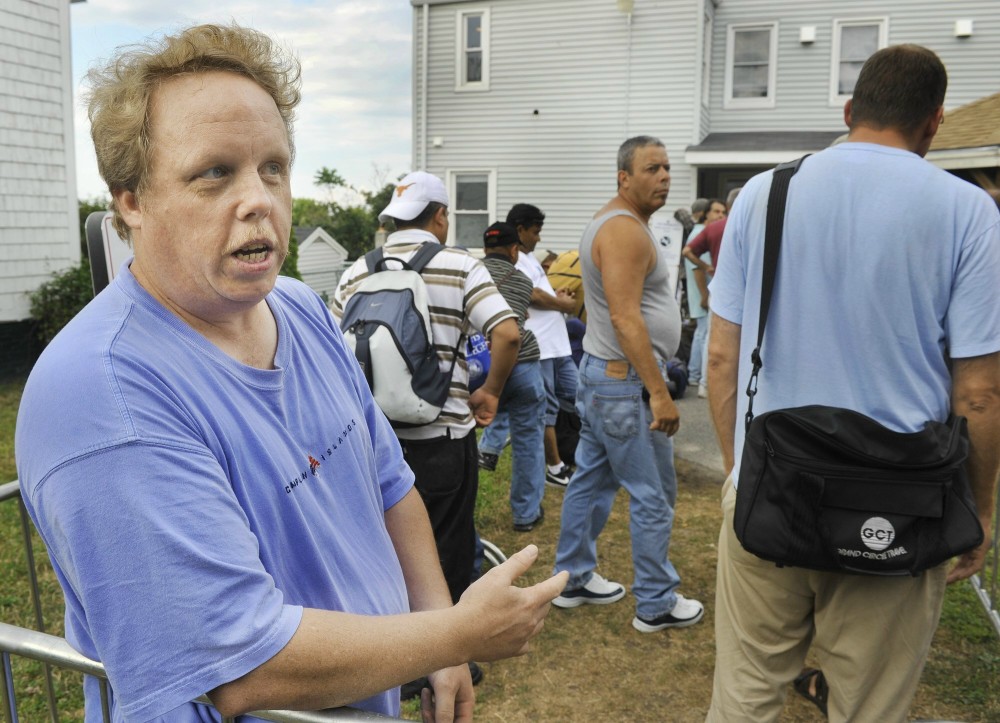PORTLAND – Downtown Portland’s homeless population is hurting businesses and a proposal to provide more shelter and services could make the problem worse, business leaders say in response to a new report by a task force on homelessness.
Among the recommendations made by the task force last month is construction of three 35-unit housing complexes for the chronically homeless, with in-house services for residents with problems such as addiction or mental illness.
Business leaders say that creating more housing could make Portland a destination for people seeking services. And city zoning could require new shelters and services to be downtown, they say, which could hurt business.
“It’s becoming increasingly intimidating to people who work and visit the downtown,” said Douglas Fuss, president of the Portland Downtown District’s board of directors. “They don’t show our city in a good light, and they can hurt our ability to be a tourist destination, and also our business.”
This week, the Portland Community Chamber sent an 11-page memo to city officials in response to the task force report, which is scheduled to be discussed at Monday’s City Council meeting.
The chamber believes the city should consider ways to make the city less attractive to homeless people, said Chris O’Neil, the chamber’s liaison to City Hall.
Among its suggestions: requiring “standards of behavior,” requiring more work in exchange for aid, and adopting a residency requirement.
O’Neil said experts would have to determine exactly what standards and conditions should be imposed.
Homelessness has long been an issue in Portland, and demand for assistance has increased by about 25 percent since the recession hit in 2008.
Demand peaked this summer, when more than 400 people regularly sought shelter at night. City shelters overflowed to the point where people were spending nights in metal chairs in the city’s General Assistance office.
Portland has had a policy of not turning away anyone who seeks shelter since 1987, when a homeless encampment was erected at City Hall to protest the closing of a shelter.
The task force was formed to suggest ways to reduce the number of homeless people in the city.
“We have a critical issue that’s facing the city,” Mayor Michael Brennan said Thursday of the report and the business community’s response. “The overarching goal for the city is to find permanent housing for people and to help them become economically self-sufficient.”
Brennan said he expects the council will accept the task force report Monday night and assign some of the recommendations to council committees for further research.
The council could act on certain recommendations as early as the spring, he said.
The chamber’s memo notes “two startling facts” from the city’s statistics: Two-thirds of people seeking shelter are from out of town or out of state, and demand peaks in the summer. Residency requirements and tougher workfare requirements could address those issues, it says.
O’Neil said the chamber also wants to ensure that any new low-income or specialized housing is not neglected and allowed to become disorderly properties.
“If the city cannot enforce tenant rules and standards that ensure pride of ownership, then the city should not lay a single brick,” O’Neil wrote.
Brennan challenged the idea that the homeless come to Portland for the benefits. They come, he said, because it is the state’s largest city.
Suzanne McCormick, president and chief executive officer of United Way Greater Portland, who helped lead the task force, has said homelessness is a regional problem that requires a regional solution.
McCormick said the task force looked at residency and standards requirements, like those suggested by the chamber, in Portsmouth, N.H., Manchester, N.H., and Burlington, Vt., and they were not effective in reducing the homeless population.
“What we found was that such requirements do not reduce the number of — or length of time someone is — homeless,” McCormick said.
The city already has a workfare program, with able-bodied clients working in various city departments, from cleaning the shelters to doing laundry at the Barron Center.
According to the most recent General Assistance annual report, the number of people participating in workfare has grown over the years.
In 2007, a total of 218 people provided 13,307 hours of work, valued at $89,000. In 2012, a total of 530 people provided 55,280 hours of work, valued at nearly $415,000.
McCormick said the task force addressed the chamber’s concern about concentrating services downtown, and recommended that housing units be developed not only in the downtown.
But establishing emergency shelters elsewhere in the city would require zoning changes, which would likely be a highly political process.
“No one wants this in their back yards, so this is a big concern for us,” Fuss said.
Brennan said housing-first apartments — like Logan Place and Florence House — would not need zoning changes to be developed off the peninsula. The city code restricts only shelters, he said.
The task force did not include cost estimates for its recommendations. The current system costs more than $6.7 million per year, and a new streamlined system could save $2.2 million in emergency care costs, the report says.
McCormick said the feedback from the business community is vital. The task force has recommended that the city form a “legacy” group to oversee and advocate for the implementation of the recommendations.
“It will take all facets of our community working together to make real change happen,” McCormick said. “I know the legacy group of the task force, if formed, will rely on participation by the chamber.”
Staff Writer Randy Billings can be contacted at 791-6346 or at:
rbillings@mainetoday.com
Twitter: @randybillings
Send questions/comments to the editors.




Comments are no longer available on this story